One of my favorite photography activities is to photograph at locations where birds of prey concentrate during winter. My initial experience of this kind was in the Antelope Valley north of Los Angeles, which definitely added a new dimension to my bird photography opportunities in southern California. So when I returned to the Northern Great Plains I was at a loss for a winter raptor photo location.
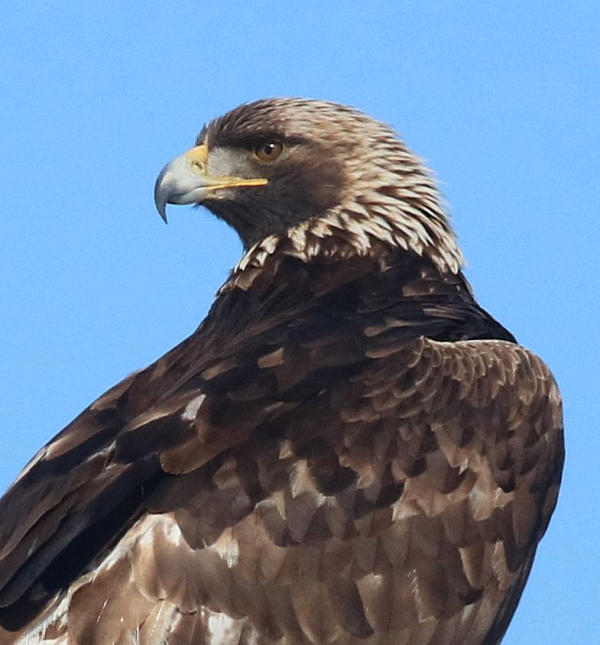
The trust level of some adult Golden Eagles wintering in central South Dakota provides opportunities to take close portraits that show a high level of detail, essentially not only showing each feather, but markings on individual feathers (photo info: 400mm telephoto lens, f-10 aperture, 1/1600 shutter speed, 400 ISO).
|
I knew there were no raptors in North Dakota during winter months, aside from a very rare urban Merlin or Sharp-shinned Hawk, or maybe a far-ranging eagle or Rough-legged Hawk. So it was quite enlightening to learn about wintering raptors in central South Dakota. After several winters I realized there is an invisible line that roughly follows the east-west route of Highway 212 in SoDak – north of that line it’s all but raptor-free; south of the 212, more and more hawks, eagles, and falcons appear in the landscape.
The capitol city of Pierre tends to be a central point of a route that I have established as my winter raptor survey area, a driving route through areas that I have found attracts the most birds of prey. For several winters I have driven the survey route periodically between November and March, although December to February is prime time and early January stands out as the peak period for raptor numbers and diversity. Actually though, censusing the raptors is secondary to finding a few birds among the many that provide photo opportunities. Therefore, I time my SoDak drives during days when the sun is shining with a minimum of wind, which produces the highest raptor numbers and the best potential to get photographs of some of the magnificent birds I encounter along the way.
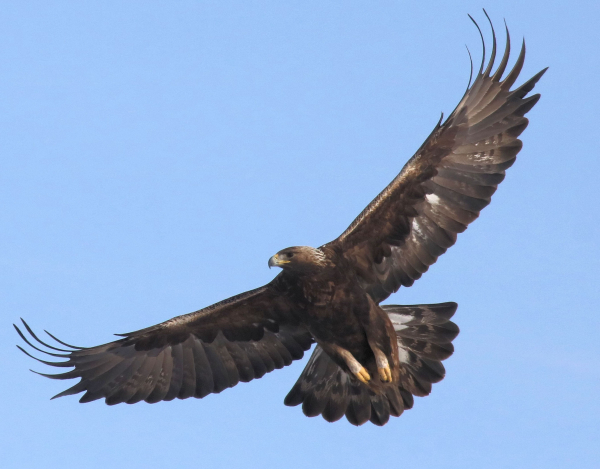
Foremost among the regal birds, I value finding Golden Eagles and Prairie Falcons, partly for their rarity elsewhere and their relative abundance along my SoDak winter raptor route. But every raptor sighting is much appreciated considering I don’t see them in my home range to the north during winter. There are usually a variety of Rough-legged Hawks, including dark morph individuals, and even the Red-tailed Hawks have a few Harlan’s Red-tails among them that include a few dark morphs and a continuing light morph Harlan’s.
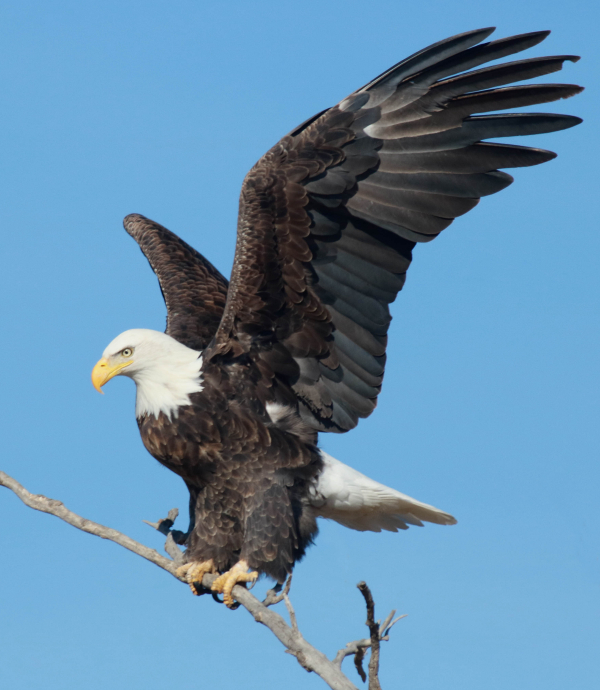
Not to be undone, a Bald Eagle shows the breadth of its long, broad wings, including the detail of the position of each underwing feather. In advance of taking this action image as the eagle repositioned on its relatively flimsy perch, the aperture was dialed to f-7 to ensure a faster shutter speed (400mm telephoto lens, f-7 aperture, 1/2000 shutter speed, 400 ISO).
|
Prairie and Taiga Merlins are possibilities, as are Northern Harriers, and Bald Eagles are standard among the regular wintering birds. Ferruginous Hawks are never a given, but they can add to the excitement in the southland, especially during some of the early weeks of winter weather. One year I even photographed a dark morph Ferrug! I might see a Cooper’s Hawk, a Sharp-shin, or an American Kestrel, but the holy grail of the region is a super-rare Gyrfalcon – I’ve seen 3 in the grasslands over the years – none recently – but there is always the chance of seeing one of these impressive Arctic visitors.
Last Wednesday the chances of a sunny day with light wind gave me reason to head south to check on raptor numbers at the beginning of the season. Although there was no snow cover, which tends to concentrate more raptors in my survey area, I found 8 species including a total of 40 raptors, which I report on in this issue’s Editor Afield article, which includes a nice series of Ferruginous Hawk photos. The trip also instilled a desire to return to SoDak soon, like tomorrow; but it also gave me the idea to share some of my favorite SoDak raptor photos with you.
Winter is a great time of the year to be in the field the full day, when the sun is fairly low in the southern sky throughout the day, and during a SoDak run it’s always a matter of checking to see which birds are approachable. Usually, I encounter the raptors as they are perched on a high perch – a post or pole that allows them to see for a distance in all directions as they hunt. The very reason the birds of prey are present in concentrated numbers is that there is an abundance of prey, mostly small rodents like voles and mice, but rabbits are in greater danger among the eagles, Red-tails, and Ferruginous Hawks, and a variety of birds are present for the falcons and some individual raptors that lean toward avian hunts.
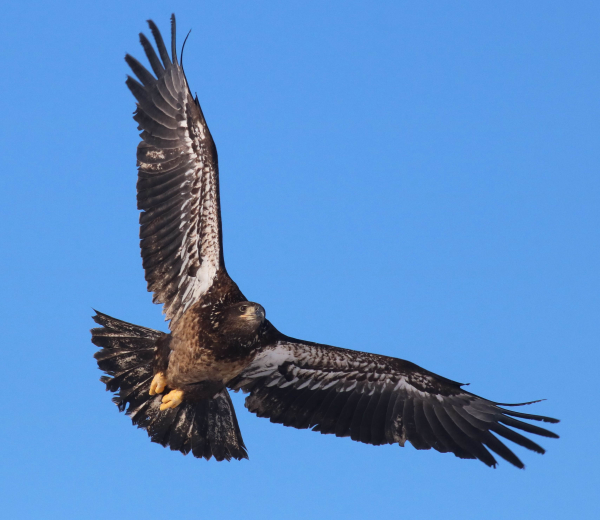
From their open perches, the raptors are usually evident from a distance, and approaching them is merely a matter of continuing down the road at a slower speed, ready to react if they take flight, trying to get within telephoto lens range of birds with the light at my back. I actually choose to drive in certain directions down given roads to ensure I have the sunlight behind me. In some cases I find that I need to try to drive past the bird to be in the correct position to avoid shadows.
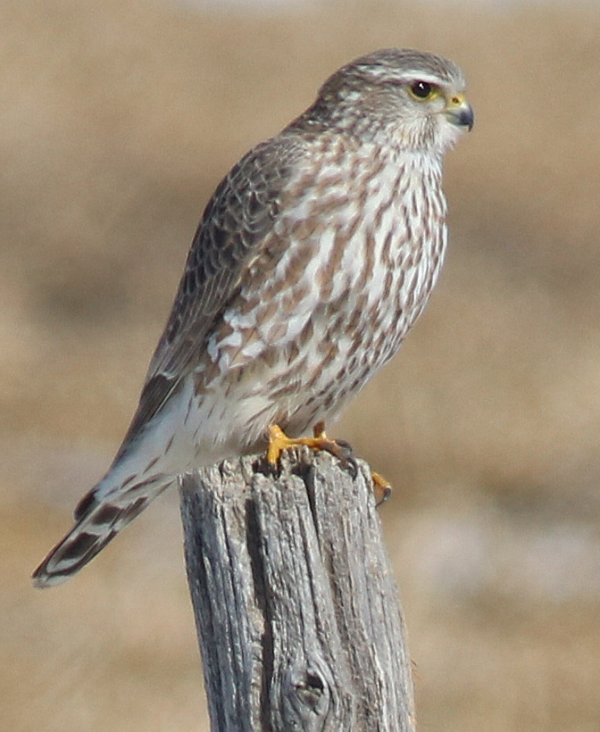
The particularly light coloration of the plumage of this Merlin is indicative of the Prairie race. With some extra time to double-check camera settings as it hunted, the aperture was dialed down to f-7 to try to throw the background out of focus to emphasize the profile of the mini-falcon. And with ample sunlight the ISO was dialed down from 400 to 200 with the hope of improving the overall photo quality (400mm telephoto lens, f-7 aperture, 1/1200 shutter speed, 200 ISO).
|
Of course, I don’t want to disturb any raptors, but in reality, I’m just driving another vehicle down the road. Whether it’s my car, a ranch vehicle, or another car or truck, the birds either remain perched or fly, so my photo activities usually aren’t an added concern for the birds. In fact, often if a raptor takes flight, it merely repositions to the next pole or a few posts down the fence line. But one of the best things about the SoDak raptors is that most of them are remarkably trusting. They rarely flush as a result of my activities – even such wary birds as eagles and Prairie Falcons.
The Golden Eagles that winter in this central South Dakota area are quite remarkable with respect to their trust of people and passing vehicles – or in my case, a stopping vehicle. Their trust is a testimony to the fact that local ranchers and other residents welcome the big birds, and that this is a very rural region with a minimum of human activity during winter months. It is likely also enhanced by the fact that some of the adult Goldens return to winter territories where they can be found annually and feel safe.
One impressive Golden Eagle in particular habitually perches on a tall pole on the side of a ranch yard near a barn, and I can think of at least 4 other adult Goldens that seem to be drawn to favorite perches on winter territories. It’s exciting to see familiar eagles and photograph them time and time again as they hunt, rest, preen, and loaf. Golden Eagles are spectacular birds that most of us rarely get to see, much less photograph and study at close quarters. I can’t over-emphasize what a thrill it is to spend time in close company of a big Golden Eagle and to photograph it under portrait-close conditions! And keep in mind, some days I see more than 20 Goldens and 20 Bald Eagles – although average daily totals tend to be more like 10 of each.
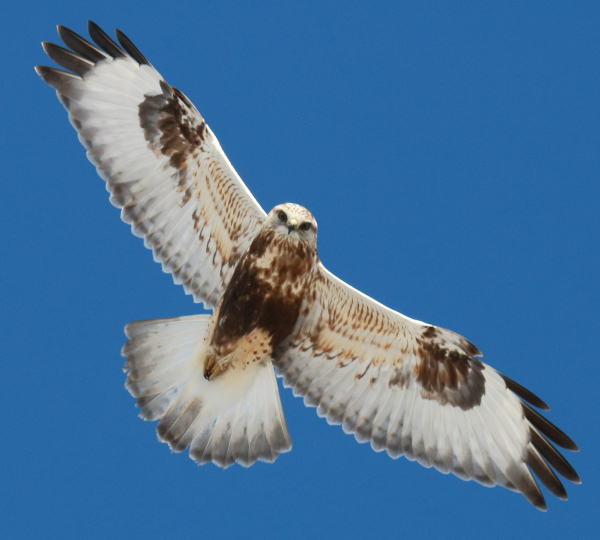
During the peak of winter I may count 45 to 70 raptors along my route, which roughly follows Highway 83 south through Pierre, past the capitol into the national grasslands and on to rural plains from the little town of Vivian to the slightly larger town of Presho, and a few more miles farther south. My best counts have been above 80 raptors, but last Wednesday I was excited to see raptors in double figures considering it was early in the season, with prolonged fall weather, and there was lack of snow cover to date, which tends to concentrate raptors along my route. But after seeing 40 raptors, and photographing a few, I’m excited to return soon.
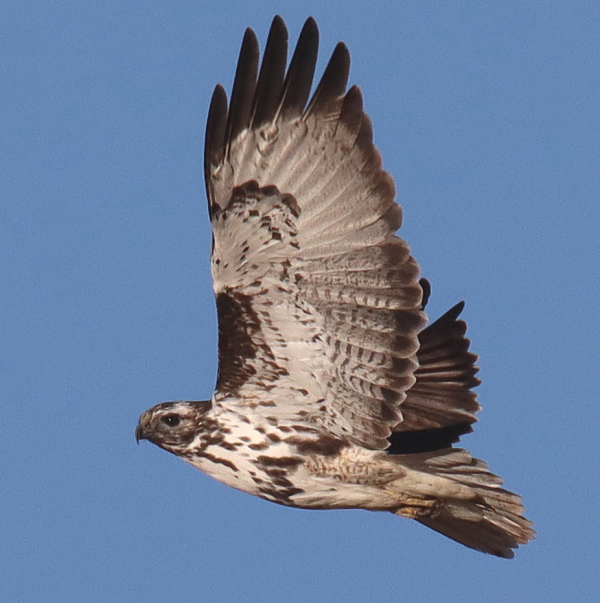
As for photo tips and tech information, I’ve shared several tidbits within this article, but I provide more in the captions for each of the photographs presented in this gallery of favorites that I have taken over the winter months in SoDak. Enjoy all the birds of prey you find this winter, and good luck as you photograph more raptors – one by one, perched and in flight, near or far. They are certainly an interesting group of birds that attract many bird photographers into the field, and their diversity across North America provides a variety of species to search out and photograph.
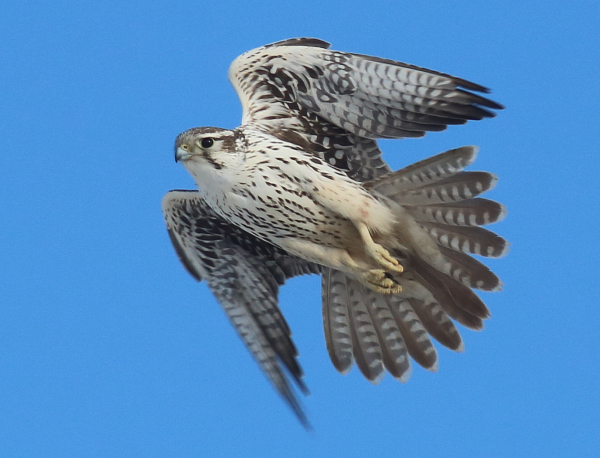
Article and photographs by Paul Konrad
Share your bird photos and birding experiences at editorstbw2@gmail.com